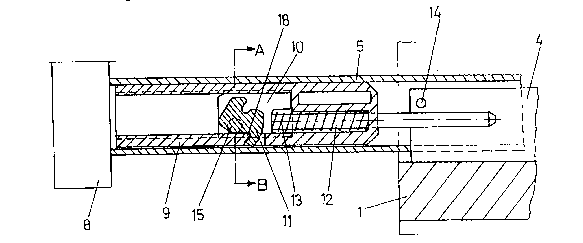Some of the information on this Web page has been provided by external sources. The Government of Canada is not responsible for the accuracy, reliability or currency of the information supplied by external sources. Users wishing to rely upon this information should consult directly with the source of the information. Content provided by external sources is not subject to official languages, privacy and accessibility requirements.
Any discrepancies in the text and image of the Claims and Abstract are due to differing posting times. Text of the Claims and Abstract are posted:
| (12) Patent Application: | (11) CA 2048153 |
|---|---|
| (54) English Title: | A CLOSING MECHANISM FOR DRAWERS |
| (54) French Title: | MECANISME DE FERMETURE DE TIROIRS |
| Status: | Deemed Abandoned and Beyond the Period of Reinstatement - Pending Response to Notice of Disregarded Communication |
| (51) International Patent Classification (IPC): |
|
|---|---|
| (72) Inventors : |
|
| (73) Owners : |
|
| (71) Applicants : |
|
| (74) Agent: | MARKS & CLERK |
| (74) Associate agent: | |
| (45) Issued: | |
| (22) Filed Date: | 1991-07-30 |
| (41) Open to Public Inspection: | 1992-02-01 |
| Examination requested: | 1998-07-28 |
| Availability of licence: | N/A |
| Dedicated to the Public: | N/A |
| (25) Language of filing: | English |
| Patent Cooperation Treaty (PCT): | No |
|---|
| (30) Application Priority Data: | ||||||
|---|---|---|---|---|---|---|
|
Abstract
A closing device for drawers. A pull-out rail (5)
attached to the drawer and a support rail (4) attached
to the body of the furniture are provided on each side
of the drawer. Load-transferring rollers are mounted
between the rails (4, 5). The closing device comprises
a pivoting segment (19, 21) that is subject to the
action of a spring and exhibits a receiving slot for a
tang (14, 22) mounted on the support rail (4). The
pivoting segment (19, 21) can be slid along pull-out
rail (5) in a straight line in the pull-out direction
of the drawer. Said pivoting segment (19, 21) is
mounted on a slide (10, 20), which is loaded by a
spring (12, 25).
Note: Claims are shown in the official language in which they were submitted.
Note: Descriptions are shown in the official language in which they were submitted.

2024-08-01:As part of the Next Generation Patents (NGP) transition, the Canadian Patents Database (CPD) now contains a more detailed Event History, which replicates the Event Log of our new back-office solution.
Please note that "Inactive:" events refers to events no longer in use in our new back-office solution.
For a clearer understanding of the status of the application/patent presented on this page, the site Disclaimer , as well as the definitions for Patent , Event History , Maintenance Fee and Payment History should be consulted.
| Description | Date |
|---|---|
| Inactive: IPC expired | 2017-01-01 |
| Inactive: IPC expired | 2017-01-01 |
| Inactive: IPC from MCD | 2006-03-11 |
| Application Not Reinstated by Deadline | 2003-06-18 |
| Inactive: Dead - Final fee not paid | 2003-06-18 |
| Deemed Abandoned - Failure to Respond to Maintenance Fee Notice | 2002-07-30 |
| Deemed Abandoned - Conditions for Grant Determined Not Compliant | 2002-06-18 |
| Notice of Allowance is Issued | 2001-12-18 |
| Notice of Allowance is Issued | 2001-12-18 |
| Letter Sent | 2001-12-18 |
| Inactive: Approved for allowance (AFA) | 2001-11-29 |
| Amendment Received - Voluntary Amendment | 2001-08-15 |
| Inactive: S.30(2) Rules - Examiner requisition | 2001-04-20 |
| Amendment Received - Voluntary Amendment | 1999-04-07 |
| Letter Sent | 1998-08-17 |
| Inactive: Status info is complete as of Log entry date | 1998-08-17 |
| Inactive: Application prosecuted on TS as of Log entry date | 1998-08-17 |
| Request for Examination Requirements Determined Compliant | 1998-07-28 |
| All Requirements for Examination Determined Compliant | 1998-07-28 |
| Application Published (Open to Public Inspection) | 1992-02-01 |
| Abandonment Date | Reason | Reinstatement Date |
|---|---|---|
| 2002-07-30 | ||
| 2002-06-18 |
The last payment was received on 2001-07-06
Note : If the full payment has not been received on or before the date indicated, a further fee may be required which may be one of the following
Please refer to the CIPO Patent Fees web page to see all current fee amounts.
| Fee Type | Anniversary Year | Due Date | Paid Date |
|---|---|---|---|
| MF (application, 6th anniv.) - standard | 06 | 1997-07-30 | 1997-06-19 |
| MF (application, 7th anniv.) - standard | 07 | 1998-07-30 | 1998-07-07 |
| Request for examination - standard | 1998-07-28 | ||
| MF (application, 8th anniv.) - standard | 08 | 1999-07-30 | 1999-07-06 |
| MF (application, 9th anniv.) - standard | 09 | 2000-07-31 | 2000-06-20 |
| MF (application, 10th anniv.) - standard | 10 | 2001-07-30 | 2001-07-06 |
Note: Records showing the ownership history in alphabetical order.
| Current Owners on Record |
|---|
| JULIUS BLUM GESELLSCHAFT M.B.H. |
| Past Owners on Record |
|---|
| ERICH ROCK |
| HELMUT HOLLENSTEIN |